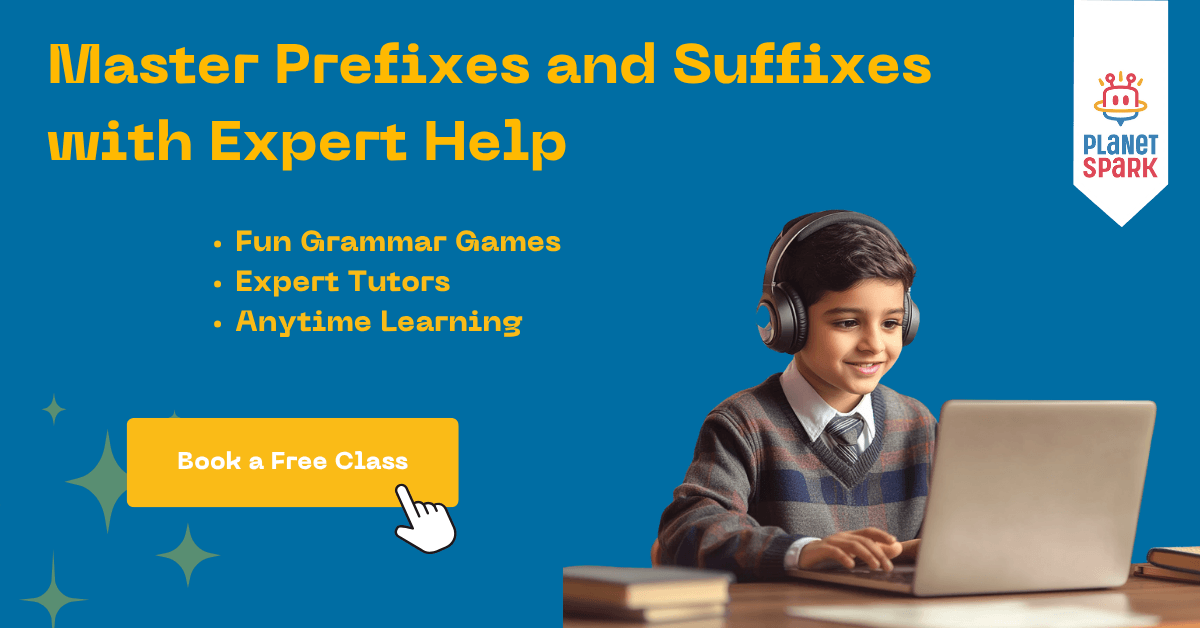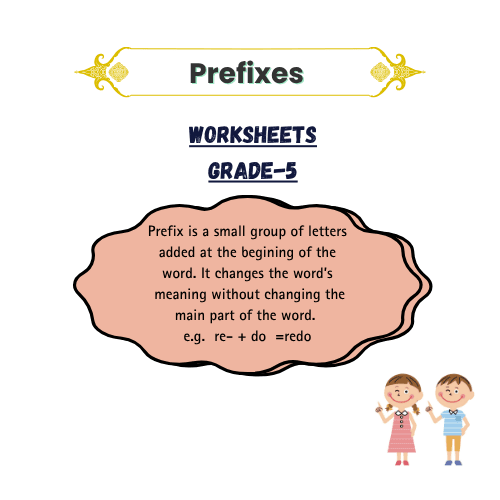Prefixes and Suffixes: A Complete Grammar Guide for Kids

Table of Contents
- Guide on Prefixes and Suffixes: A Kid-Friendly Breakdown
- Common Prefixes and Suffixes for Kids
- Prefix vs Suffix: What’s the Difference?
- Why Should We Learn Prefixes and Suffixes?
- Common Prefixes and Their Meanings
- How to Teach Prefixes and Suffixes at Home
- Real-Life Benefits of Learning Prefixes and Suffixes
- Build a Strong Grammar Foundation with PlanetSpark
- Conclusion
- FAQs: Prefixes and Suffixes
Have you ever wondered how a simple word like happy can become unhappy or happiness? That’s the power of prefixes and suffixes, tiny additions that completely change a word’s meaning or function. Understanding how these word parts work is one of the easiest ways to boost your child’s vocabulary, spelling, and grammar.
In this blog, we’ll explore what prefixes and suffixes are, how they work, and why mastering them is essential for confident reading and writing. With kid-friendly examples, engaging tips, and clear breakdowns, this is your go-to resource for making word-building fun and effective!
Guide on Prefixes and Suffixes: A Kid-Friendly Breakdown
Building a strong vocabulary doesn’t have to be boring! One of the most exciting ways to grow your English skills is by learning about prefixes and suffixes. These tiny parts of words might look small, but they have the power to completely change what a word means or how it works in a sentence.
This guide on prefixes and suffixes is specially made for kids. With simple explanations, fun comparisons, and easy examples, you'll be able to understand and use these word parts like a language pro.
What Is a Prefix?
A prefix is a group of letters that you add to the beginning of a word. When you do this, the meaning of the word changes. It’s like adding a magic spell to a word and giving it a brand-new meaning.
Think of a prefix like a superhero’s cape, it gives the word a whole new power!
Let’s look at some examples:
| Prefix | Root Word | New Word | New Meaning |
|---|---|---|---|
| un- | happy | unhappy | not happy |
| re- | play | replay | to play again |
| mis- | behave | misbehave | to behave wrongly |
| pre- | cook | precook | to cook beforehand |
| dis- | agree | disagree | to not agree |
Quick tip: Most prefixes have a clear and consistent meaning.
- “un-” means not
- “re-” means again
- “pre-” means before
Once you learn the meanings of common prefixes, you can guess the meanings of many new words without using a dictionary

Your Child Deserves the Best Start in English Grammar
Book a Free Trial and See the Difference in One Session.
What Is a Suffix?
A suffix is a group of letters added to the end of a word. It can change how a word is used, turning it into a noun, verb, adjective, or even changing its tense.
Imagine a suffix as a special hat the word wears, it gives the word a new role or appearance!
Here are some suffix examples:
| Root Word | Suffix | New Word | New Meaning |
|---|---|---|---|
| teach | -er | teacher | someone who teaches |
| quick | -ly | quickly | in a quick way |
| care | -less | careless | without care |
| act | -ion | action | the process of acting |
| read | -ing | reading | the act of reading |
Suffixes can help you describe how something is done (slow → slowly), who is doing an action (paint → painter), or even what kind of thing it is (hope → hopeless).
Common Prefixes and Suffixes for Kids
Here is a handy table of common prefixes and suffixes that you’ll come across often in grammar lessons, storybooks, and classroom activities.
Common Prefixes:
| Prefix | Meaning | Example Words |
|---|---|---|
| un- | not | unhappy, unfair |
| re- | again | redo, rewrite |
| pre- | before | preview, preschool |
| dis- | not or opposite | disconnect, dislike |
Common Suffixes:
| Suffix | Meaning | Example Words |
|---|---|---|
| -er | one who does | teacher, painter |
| -ful | full of | beautiful, helpful |
| -less | without | hopeless, fearless |
| -ly | in a certain way | quickly, kindly |
| -ing | action or process | playing, running |
Prefix vs Suffix: What’s the Difference?
While both prefixes and suffixes are word parts that change meaning, they work in different ways and appear in different places in a word.
Let’s break it down:
| Feature | Prefix | Suffix |
|---|---|---|
| Where it goes | At the beginning of a word | At the end of a word |
| What it does | Changes the meaning of a word | Changes the form or function |
| Example | un + lucky = unlucky | luck + y = lucky |
| Another Example | pre + heat = preheat | heat + ed = heated |
Prefix = Pre (before) → It comes before the root word.
Suffix = Stuck after → It’s stuck on at the end of the word.
Think of it like decorating a gift:
A prefix is like the ribbon tied on the front.
A suffix is like the name tag stuck on the back.
Why This Difference Matters
Understanding where and how prefixes and suffixes work helps kids:
Decode unfamiliar words in reading.
Spell words correctly in writing.
Build better vocabulary with ease.
By learning to spot prefixes and suffixes, kids can quickly understand and use hundreds of new words without memorising them all individually!

Make Grammar Easy and Exciting
Reserve a Free Demo Class with PlanetSpark’s Expert Tutors!
Why Should We Learn Prefixes and Suffixes?
Learning prefixes and suffixes helps kids unlock the power of language. These tiny word parts may look small, but they can help children understand new words, improve reading fluency, and become stronger writers.
Here’s why learning prefixes and suffixes is so useful:
1. Build a Bigger Vocabulary
Prefixes and suffixes help you guess the meaning of unfamiliar words. For example, if you know that "un" means not, you can figure out that unfriendly means not friendly. Suddenly, big words become easier to understand!
2. Read with Confidence
When children can break down long or tricky words into root words, prefixes, and suffixes, reading becomes smoother. Instead of stumbling over a big word like “misunderstood,” they see it as mis + understood — and they get the meaning right away.
3. Improve Spelling and Writing
Knowing how prefixes and suffixes work helps kids spell words correctly. For instance, once a child learns how to spell happy and understands how un- works, they can easily spell unhappy. It also helps them choose better words when writing.
4. Understand Word Families
Words with the same root can take on different meanings by adding prefixes or suffixes.
For example: act, actor, action, react, inactive, all come from the same root!
This teaches children how words are connected and helps them make sense of English grammar.
5. Do Better in Exams and Class
School worksheets, tests, and reading comprehension activities often include questions about prefixes and suffixes. Mastering them early helps kids feel more prepared and confident.
6. Fun with Word Play
Kids who understand prefixes and suffixes can play fun word games. They can create silly or creative new words and become better at solving puzzles like crosswords or word scrambles.
Common Prefixes and Their Meanings
Prefixes are added before the root word. They change the meaning of the word in helpful ways. Here are some common prefixes children should learn:
| Prefix | Meaning | Examples |
|---|---|---|
| un– | not | unhappy, unfair |
| re– | again | rewrite, redo |
| pre– | before | preview, preheat |
| dis– | opposite of | dislike, disconnect |
| mis– | wrong/badly | misplace, misbehave |
| in– | not | inactive, invisible |
👉 Tip: Try having your child highlight or list words with these prefixes from a story or article to reinforce learning!
Common Suffixes and Their Meanings
Suffixes are added after the root word. They often change the part of speech (like turning a verb into a noun) or add meaning like time, action, or condition.
| Suffix | Meaning/Use | Examples |
|---|---|---|
| –ful | full of | helpful, joyful |
| –less | without | hopeless, careless |
| –ly | how something is done | quickly, kindly |
| –ness | state of being | kindness, darkness |
| –er | one who, more | teacher, faster |
| –able | can be done | readable, breakable |
👉 Fun Tip: Create a word tree. Start with one root word (like “care”) and branch out with all the words you can make: careful, careless, caregiver, uncaring, etc.
How to Teach Prefixes and Suffixes at Home
Whether you’re a parent, teacher, or tutor, here are simple strategies to help kids learn:
1. Root Word First
Start with a simple root word, then ask kids to add different prefixes or suffixes to see how the meaning changes.
Example: play → replay, player, playful, unplayable
2. Prefix/Suffix of the Day
Introduce one prefix or suffix daily. Use it in multiple contexts and ask kids to come up with 5 new words using it.
3. Games and Flashcards
Make flashcards with prefixes, suffixes, and root words. Kids can mix and match to form real and silly words. It helps reinforce learning while having fun.
4. Word Hunts
Challenge kids to hunt for prefix and suffix words in books, articles, or even signs and packaging at home.
5. Practice with Worksheets
Use online worksheets or activity books to provide more structure. Include fill-in-the-blank, matching, and multiple-choice questions.
Real-Life Benefits of Learning Prefixes and Suffixes
Children who are confident with prefixes and suffixes:
Understand school instructions better
Decode unfamiliar words in science and math (e.g., triangle, submarine)
Communicate more clearly
Feel more confident in reading and writing
Score higher in English tests and Olympiads

Build a Strong Grammar Foundation with PlanetSpark
Mastering prefixes and suffixes is more than just a vocabulary skill, it’s a key part of building strong grammar. At PlanetSpark, our English Grammar courses are designed to help children understand how language works, right from word formation to sentence structure.
With expert-led live classes and fun, interactive lessons, your child will:
Learn how prefixes and suffixes change word meanings
Understand grammar rules through real-life examples
Improve reading comprehension by spotting word roots quickly
Boost writing and speaking fluency with confident word use
Our programs make grammar exciting and easy to understand for children from Grade 2 and up. Whether it's decoding new words or polishing grammar skills, PlanetSpark ensures your child gains the clarity and confidence they need.
Conclusion
Prefixes and suffixes are more than just parts of words, they're tools that help children unlock meaning, build vocabulary, and develop a deeper understanding of English grammar. By learning how to add and identify these word parts, kids can strengthen both their reading and writing skills. Whether your child is reading a new story or writing their own, a solid grasp of prefixes and suffixes gives them the confidence to explore language creatively and correctly.
Encourage your child to keep exploring word formation through games, reading, and interactive grammar lessons. With the right guidance and resources, even tricky grammar concepts like prefixes and suffixes can become fun and rewarding.
FAQs: Prefixes and Suffixes
Q1. What is a prefix?
A prefix is a group of letters added at the beginning of a word to change its meaning. For example, “un” in “unhappy” changes the meaning of “happy” to its opposite.
Q2. What is a suffix?
A suffix is a group of letters added at the end of a word to change its form or meaning. For example, “-ful” in “joyful” turns the noun “joy” into an adjective.
Q3. Why are prefixes and suffixes important in grammar?
They help children understand how words are formed, improve vocabulary, and make reading and writing easier by recognizing word patterns.
Q4. At what age should children start learning prefixes and suffixes?
Most children can start learning basic prefixes and suffixes around Grade 2, as part of their early grammar and vocabulary development.
Q5. How can I help my child learn prefixes and suffixes at home?
Use flashcards, play word games, read books together, and practice identifying common prefixes and suffixes in everyday language.
Q6. How does PlanetSpark teach grammar concepts like prefixes and suffixes?
PlanetSpark offers engaging online classes that break down grammar rules using visuals, activities, and real-life examples. Children learn how prefixes and suffixes work through practice and guided instruction from expert teachers.
Download Free Worksheets
Personalized Communication Report
Record a video to get a AI generated personalized communication report for your child

Hi There, want to try these
tips for your child with
LIVE with our expert coach?
Let's check your child's
English fluency

